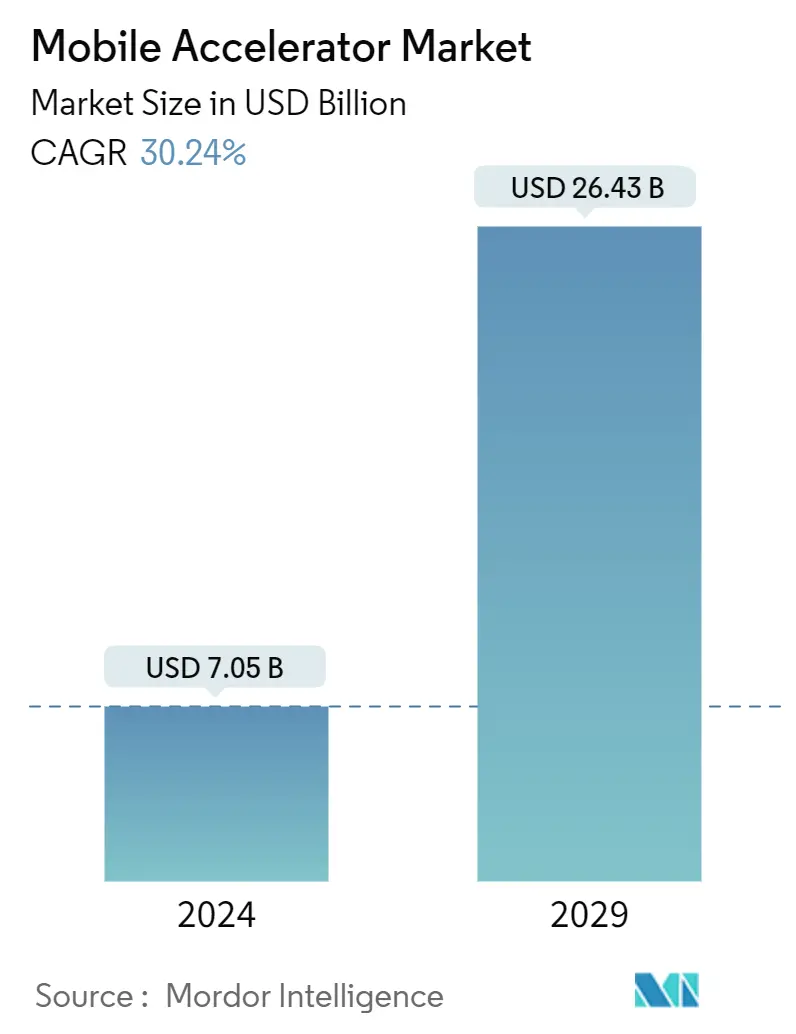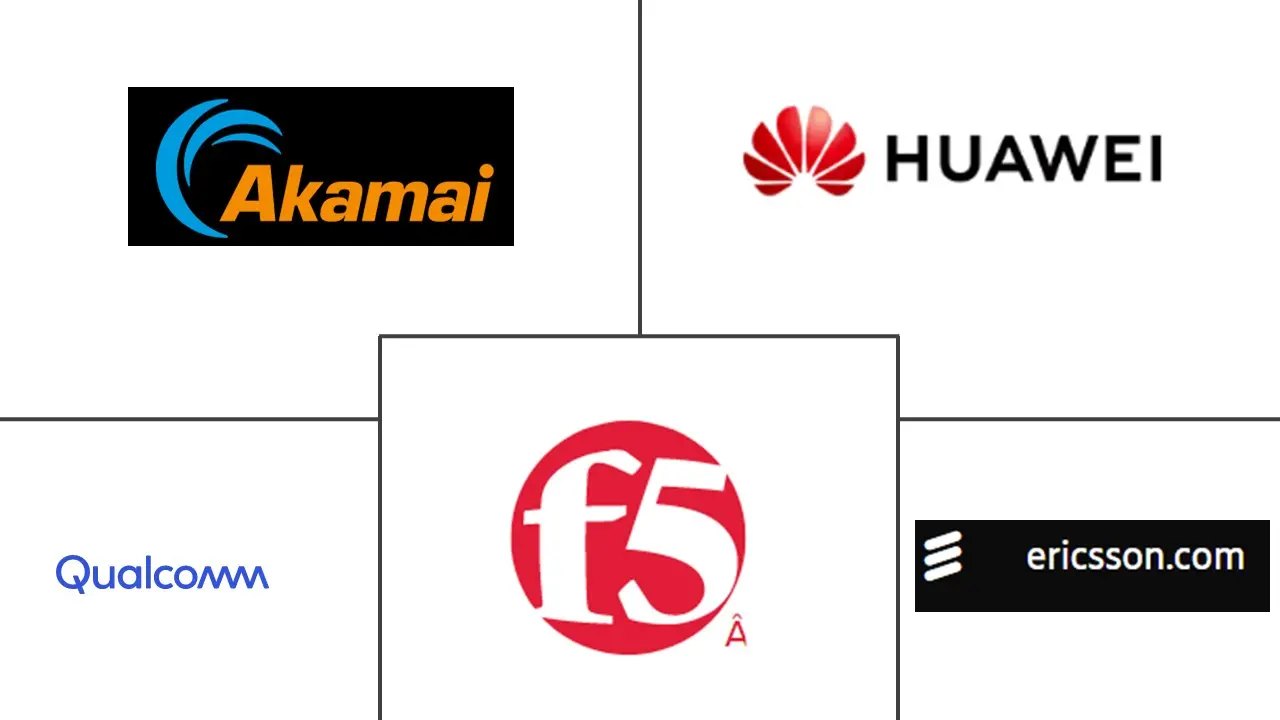Market Size of Mobile Accelerator Industry

| Study Period | 2019 - 2029 |
| Market Size (2024) | USD 7.05 Billion |
| Market Size (2029) | USD 26.43 Billion |
| CAGR (2024 - 2029) | 30.24 % |
| Fastest Growing Market | Asia Pacific |
| Largest Market | North America |
Major Players
*Disclaimer: Major Players sorted in no particular order |
Mobile Accelerator Market Analysis
The Mobile Accelerator Market size is estimated at USD 7.05 billion in 2024, and is expected to reach USD 26.43 billion by 2029, growing at a CAGR of 30.24% during the forecast period (2024-2029).
Mobile accelerators use various techniques to improve app performance, including data compression, content optimization, and caching. They can also help reduce the amount of data mobile apps use, which can be particularly useful for users with limited data plans.
- The rising use of mobile devices and the growing relevance of mobile apps for organizations drive the need for mobile accelerators. As more businesses rely on mobile applications to interact with consumers, the demand for mobile accelerators to optimize app performance will increase.
- Mobile traffic has increased drastically in recent years, which drives the mobile accelerator market. Mobile traffic has exceeded desktop traffic in several nations as more people use smartphones and tablets to access the internet. This development has emphasized mobile marketing strategies and approaches to target this expanding audience.
- In order to increase the business's strength and user experience quality, Mobile Accelerator is designed to accelerate and optimize web, content, network and applications. In order to reduce the complexity of mobile users, the technology helps network operators to overcome problems such as latency, round trip timeRTT, and to improve scalability, availability and performance, thereby reducing the complexity of mobile users.
- The mobile accelerator market faces significant security challenges as data is shared with third-party vendors. These challenges can restrain the market's growth and hinder businesses' and individuals' adoption of mobile accelerators.
- During the COVID-19 pandemic, mobile accelerator programs adapted to the new normal by offering virtual support to startups. The pandemic has also alloed to led to increased adoption of digital technology, creating new opportunities for mobile accelerator programs that support and guide entrepreneurs in the field of mobile applications.
Mobile Accelerator Industry Segmentation
The mobile accelerator is a service that gives a platform for mobile application development. It could be cloud-based, which allows anyone to quickly create, test, and publish sophisticated cross-platform mobile apps. The major application of a mobile accelerator would be in a ming application, social networking applications, and music and messaging applications, among others.
The mobile accelerator market is segmented by device (smartphone, tablet), by type (content/web applications, content delivery network acceleration, WAN optimization, mobile application accelerator, device/user end acceleration), by application (gaming applications, M-Commerce applications, location-based service applications, social networking applications, music and messaging applications), by geography (North America, Europe, Asia-Pacific, Latin America, Middle East and Africa). The market sizes and forecasts are provided in terms of value in USD for all the above segments.
| By Device | |
| Smartphones | |
| Tablets | |
| Other Devices |
| By Type | |
| Content/Web Applications | |
| Content Delivery Network Acceleration | |
| WAN Optimization | |
| Mobile Application Accelerator | |
| Device/User End Acceleration | |
| Other Types |
| By Application | |
| Gaming Applications | |
| M-Commerce Applications | |
| Location-based Service Applications | |
| Social Networking Applications | |
| Music and Messaging Applications | |
| Other Applications |
| By Geography | |
| North America | |
| Europe | |
| Asia-Pacific | |
| Latin America | |
| Middle East and Africa |
Mobile Accelerator Market Size Summary
The Mobile Accelerator Market is poised for significant growth, driven by the increasing reliance on mobile devices and applications across various sectors. As businesses strive to enhance user engagement and optimize app performance, the demand for mobile accelerators is on the rise. These technologies employ techniques such as data compression, content optimization, and caching to improve app efficiency and reduce data consumption, making them particularly valuable for users with limited data plans. The surge in mobile traffic, which has surpassed desktop traffic in many regions, underscores the importance of mobile marketing strategies and the need for robust mobile application performance. However, the market faces challenges related to security, as data sharing with third-party vendors poses potential risks to user privacy and data integrity.
The Asia-Pacific region is experiencing rapid growth in the mobile accelerator market, fueled by the widespread adoption of mobile technologies and the demand for high-performance applications. Countries like China, India, and South Korea are at the forefront of this expansion, supported by significant investments in mobile infrastructure and 5G network deployment. The market is characterized by a high level of fragmentation, with major players such as Akamai Technologies Inc., Qualcomm Inc., and Huawei Technologies Co. Ltd. actively engaging in partnerships, innovations, and strategic acquisitions to enhance their offerings. These developments are expected to drive further advancements in mobile application performance and service efficiency, ensuring continued market growth in the coming years.
Mobile Accelerator Market Size - Table of Contents
-
1. MARKET INSIGHTS
-
1.1 Market Overview
-
1.2 Industry Attractiveness - Porter's Five Forces Analysis
-
1.2.1 Bargaining Power of Buyers/Consumers
-
1.2.2 Bargaining Power of Suppliers
-
1.2.3 Threat of New Entrants
-
1.2.4 Threat of Substitute Products
-
1.2.5 Intensity of Competitive Rivalry
-
-
1.3 Industry Value Chain Analysis
-
1.4 Impact COVID-19 on the Market
-
-
2. MARKET SEGMENTATION
-
2.1 By Device
-
2.1.1 Smartphones
-
2.1.2 Tablets
-
2.1.3 Other Devices
-
-
2.2 By Type
-
2.2.1 Content/Web Applications
-
2.2.2 Content Delivery Network Acceleration
-
2.2.3 WAN Optimization
-
2.2.4 Mobile Application Accelerator
-
2.2.5 Device/User End Acceleration
-
2.2.6 Other Types
-
-
2.3 By Application
-
2.3.1 Gaming Applications
-
2.3.2 M-Commerce Applications
-
2.3.3 Location-based Service Applications
-
2.3.4 Social Networking Applications
-
2.3.5 Music and Messaging Applications
-
2.3.6 Other Applications
-
-
2.4 By Geography
-
2.4.1 North America
-
2.4.2 Europe
-
2.4.3 Asia-Pacific
-
2.4.4 Latin America
-
2.4.5 Middle East and Africa
-
-
Mobile Accelerator Market Size FAQs
How big is the Mobile Accelerator Market?
The Mobile Accelerator Market size is expected to reach USD 7.05 billion in 2024 and grow at a CAGR of 30.24% to reach USD 26.43 billion by 2029.
What is the current Mobile Accelerator Market size?
In 2024, the Mobile Accelerator Market size is expected to reach USD 7.05 billion.

